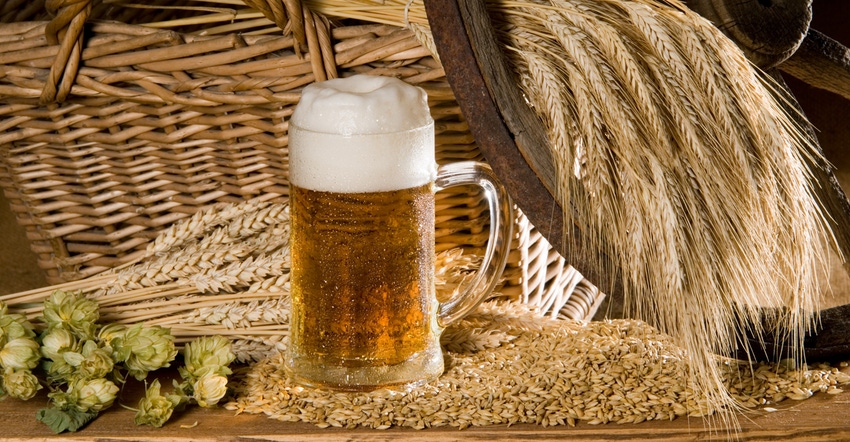March 26, 2018

By Clint Nester
In case you haven’t noticed, there is a craft beer boom happening across the nation and right here in Ohio. A study by the National Beer Wholesalers Association and the Beer Institute shows the craft beer industry contributed more than $13.2 billion to the Ohio economy in 2016, a $2 billion increase from 2015. There is currently an effort under way by a private company, Origin Malts, to build a barley malting facility in central Ohio, which could be good news for Ohio farmers.
What opportunities are there for barley in Ohio?
Traditionally the barley being utilized for malting was spring barley produced in the northern U.S., Canada and winter barley grown in the U.K. There is potential for Ohio and other Great Lakes states to produce quality winter barley due to their climate having moisture during seedling establishment in the fall and throughout the grain fill period. Dr. Eric Stockinger of the Ohio State University Department of Horticulture and Crop Science began a winter barley breeding program in 2009. Stockinger is working with over 4,000 lines of barley in an effort to maximize winter hardiness, disease resistance and yield potential. The varieties of Puffin (2-row) and Maja (6-row) are the current front runners. However, several other varieties being tested show promise as well.
In fall 2017 OSU Extension published a barley malting guide, "Management of Ohio Winter Malting Barley," which serves as an excellent guide to producers looking to grow winter barley.
When and how should barley be planted?
Winter barley can be planted after the Hessian fly-free date in September in northern Ohio and October in southern Ohio. Seeding rates should be based on seeds per acre due to variable seed size. OSU recommends 1.2 to 1.6 million seeds per acre in 7.5 inch rows when planted 2 weeks after the fly-free date and 1.7 to 2.0 million seeds per acre during the third and fourth week following the fly-free date. Research studies are currently under way to look at different seeding rates.
Fertility requirements for winter barley are very similar to that of wheat production. The biggest difference is with nitrogen management, where over application can lead to lodging and high protein levels, which results in low malting quality. Trials at OARDC Wooster have applied 20-30 pounds of N per acre in the fall, with an additional 90 pounds of N per acre in the spring. This program has resulted in yields of 80-90 bushels per acre, and protein levels of 9.5% to 12.5%. Growers with plots in northwest Ohio have seen yields over 100 bushels per acre.
What concerns are there for growers?
Disease control will be critical for the barley to meet malting standards. The primary concern is head blight (scab), which can produce toxins that are harmful to humans and animals. The toxin deoxynivalenol (DON) is tested to determine the fungal contamination in grain. Barley with levels exceeding 1 ppm DON will be rejected for malting purposes. Growers should plan on two fungicide passes to minimize DON levels.
Winter barley can be harvested in mid-June to early July, usually about two weeks ahead of wheat harvest. Care must be taken to protect the quality of the grain as damaged kernels or grain with poor germination will be unusable for malting. Harvest moisture levels should be about 13%. If heat is used for drying purposes then it should be less than 100 degrees F to avoid injury to germination. According to Stockinger, market value for malting barley is expected to be $6 to $7 per bushel. Due to harvest timing, growers in Ohio have had some success double cropping soybeans behind winter barley.
How should barley be stored?
Once harvested, barley should be stored in dedicated bins free of pests and disease. Composite samples will be collected and submitted to a barley quality laboratory for testing. A barley test report should include test weight, moisture, percent plump, germination percent, pre-harvest sprout, vomitoxin and protein content. As mentioned before, grain quality and integrity is of the utmost importance to meet malting standards.
As the craft beer industry continues to grow, so will the need for malting barley. By adding barley to the rotation, a grower can diversify and increase soil health benefits. Another benefit of barley in the rotation is the reality of having a growing crop on the landscape for 13-14 months when followed with double-cropped soybeans. If planted in significant amounts, winter barley could have a very positive effect on water quality in the Great Lakes states. Additionally, the premium for malting barley with the ability to double crop soybeans offers an opportunity to improve a producer’s bottom line.
Nester is certified crop adviser with Nester Ag LLC. Email him at [email protected].
You May Also Like




